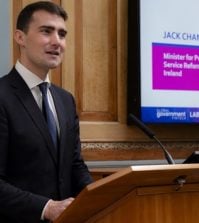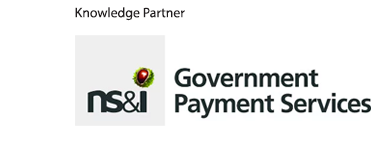Singapore’s digital pioneers: Global Government Finance Summit, part 5

Not every nation enjoys the advantages that have enabled Singapore to lead the way in digital public services. But as delegates learned at the 2018 Global Government Finance Summit, there is much to learn from the city-state’s experience. Matt Ross reports
Singapore has a well-deserved reputation as a trailblazer in digital public services. So at the 2018 Global Government Finance Summit, the audience of senior civil service finance professionals were eager to learn how the city-state has managed to build systems as advanced and accessible as those of major tech businesses.
Speaking to delegates from 11 countries gathered at the Summit – hosted this year in Berlin by the German government, and supported by EY and Microsoft – Paul Loke, Director of Technology and Chief Information Officer at Singapore’s Accountant General Department, started out by explaining how civil servants had built firm foundations for new public services. And in the digital world, the foundation of most services is data.
Recent legislation, he explained, places an expectation on departments to share data across government: “We have the privilege of being able to pull all that data into a single data warehouse, and that allows us to look at things across the board,” he said.
Building on the foundations
At the other end of public services, of course, stand service users – and here, Singapore has concentrated on making services accessible via mobile phone apps. As Loke explained, “Singapore’s a connected nation, with a 150% mobile phone penetration rate” and 20,000 wireless hotspots.
Using mobile apps maximises both coverage and accessibility, explained Ow Fook Chuen, Singapore’s Accountant General: “Many low income workers have mobile phones; they’re more inclusive than desktops,” he said; the government tries to build apps whose “usage is so intuitive that even someone without much know-how or expertise can use them.”
Given a single data pool and user access via mobile phones, said Loke, the government has built a wide range of new services for citizens and officials alike. The MyInfo data platform, for example, allows people to automatically populate online forms with their personal information. This has paved the way for a digital signatures system that by 2022 will, Loke explained, provide online identity verification for both government and private sector services. And last year, the government launched PayNow – allowing individuals to transfer funds simply and instantaneously.

The MyInfo data platform, paving the way for digital signatures.
To boost takeup of new services, added Ow Fook Chuen, citizens are often incentivised to use digital channels: “We give back the efficiency gains. So if you apply for a passport on the digital service, it’s cheaper. When we introduced a digital parking system, we allowed people to pay by the minute rather than in 30-minute blocks.”
Easing the operation of government
Singapore has pushed just as hard in developing administrative services to ease and improve the operation of government departments. Its Vendors@Gov portal, for example, allows suppliers to submit invoices to any government body; they can then see the anticipated payment date in their payment dashboard. And new systems are being developed to squeeze fraud and nepotism out of the supplier system: the FINNET platform “pulls data from the registry of companies, from government payments, from all the different systems – including people’s addresses” to search for potential conflicts of interest, said Loke. So if a director of a supplier business has, for example, a relative employed in the buying department, the potential conflict of interest can be identified and staff alerted.
Within the civil service, Loke continued, digital services have streamlined administration. Online platforms are used to manage pay and leave requests, and officials can submit expenses claims by photographing their receipts. Car mileage charges can be calculated by using GPS to record journey times and routes, and exploratory work is underway to use optical character recognition to detect the times printed on receipts – spotting anomalies that might suggest fraud or errors.
This requires some pretty advanced technology – and Loke explained that the government is using machine learning to analyse patterns in its vast data store. Officials are using “robotics systems to audit salaries and payments in the public sector, and machine learning to automatically classify data entries in the system,” he said.

The FINNET platform helps squeeze fraud and nepotism out of the supplier system.
What do the public want?
How can civil servants know how citizens want to receive services, asked Dmitri Jegorov, the Deputy Secretary General for Tax and Customs Policy in Estonia’s Ministry of Finance. “We didn’t know that we wanted an iPhone before it was invented,” he pointed out. “If we’re truly revolutionising products, I think citizens will not be able to tell us what they look like. How do you uncover citizens’ real needs?”
Citizen surveys can provide useful data, replied Rosemary Huxtable, the Secretary of Australia’s Department of Finance; but officials need to consider people’s journeys through public services, identifying where they encounter obstacles and poor transitions. In Singapore, explained Loke, civil servants scrutinise the “pain points” experienced by service users around “the major milestones in life: buying a house, having a kid, going to school”, then they “come up with a hypothesis, and test it with citizens.”
Louisa Unterasinger, Chief Digital Officer in Austria’s Ministry of Finance, explained that her team used a similar approach when developing a new company foundation service. Asking businesspeople about the existing system, they learned that “the real problems were quite different from the issues we’d identified”; then they “used rapid prototyping, testing solutions very quickly” with businesspeople through an iterative development process to identify what users really want.

Louisa Unterasinger, chief digital officer in Austria’s Ministry of Finance
Lessons to learn
The group were impressed by – and a little envious of – Singapore’s well-developed digital services; but some pointed out that bigger and more devolved nations would find it hard to emulate the city-state’s approach.
“We don’t have the same experience as Singapore; we don’t have responsibility for everything [at the federal level], so we can’t necessarily find the same connections,” pointed out Australia’s Huxtable. And Torsten Arnswald, Head of the Fiscal Policy Division in Germany’s Federal Ministry of Finance, could empathise: Germany’s government “has set up a taskforce which will coordinate digital processes,” he said – but “the Federal Ministry of Finance has, of course, limited scope to intervene in the affairs of the states and the municipalities.”
In Huxtable’s experience, she noted, “there has to be some sort of ‘burning platform’ that demands change.” Australian departments have been required to find substantial efficiency savings every year, “and it’s become almost impossible for secretaries to run their departments in the traditional way; so they have the incentive to work together and build shared platforms to reduce costs.”
Singapore has a long-standing government with a clear and ambitious digital strategy, a small and highly-connected population, and control of all the main levers of public services. And this experience far from typical: most nations’ civil servants operate with fewer tools, greater complexity and less political cover. Yet there is much to learn from Singapore’s approach and experience – and where civil service leaders grasp the nettle, then can make good progress.

Dmitri Jegorov, the deputy secretary general for Tax and Customs Policy in Estonia’s Ministry of Finance.
“In my experience, ministers want a good outcome for the citizen, but public sector reform isn’t always the highest priority,” said Huxtable. “So they leave us to work it out, which is great: we can work together collaboratively to come up with a good outcome.”
Estonia’s Jegorov wholeheartedly agreed. “It’s not high on the political agenda to make public services more efficient,” he concluded. “So it’s up to public servants.”
This is part five of our report on the 2018 Global Government Finance Summit: the next instalment will be published next week. Part one examined the Compact for Africa; part two explored the use of blockchain in public finance management; part three covered Finland’s reforms of health and social care delivery; and part four explored Australia’s use of digital technologies in policymaking and service delivery.























